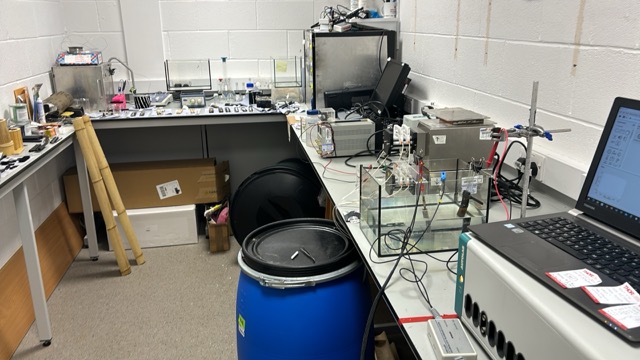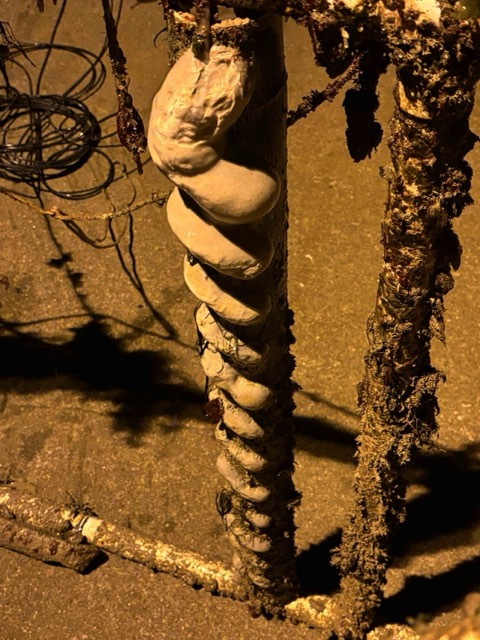

2.0m
10.0m
2.50m
The BEARS project set out to address a core limitation in the field of electrochemical artificial reefs: the reliance on conductive metals such as steel for mineral accretion. Traditional Electrochemical Artificial Reefs (EARs) use an applied electrical potential to induce the precipitation of calcium, magnesium and other minerals from seawater, forming a protective calcareous layer. While effective, these systems constrain design options and carry high material, carbon and deployment costs.
BEARS aimed to break this dependency by developing a Bio-based Electrochemical Artificial Reef (BEAR) that can form mineral rock on electrically insulating substrates. The project focused on bamboo as a primary material due to its global availability, high strength-to-weight ratio, and favourable sustainability profile. Achieving reliable electrochemical performance on such a substrate required advances in surface coatings, catalyst formulations, power delivery and structural design.
One of the most significant outcomes of BEARS was the development and optimisation of electroactive coatings capable of driving hydrogen evolution and mineral accretion on non-conductive surfaces. Testing revealed that biomass-derived catalysts could outperform commercial carbon alternatives. The team mapped how coating adhesion, substrate porosity and surface roughness affected mineral deposition, leading to a set of practical pre-treatment guidelines for bamboo, including sanding, texturing and selective sealing.
Laboratory trials demonstrated that, when properly coated, bamboo can support sustained electrolysis and produce calcareous growth with predictable morphology. Experiments across multiple potentials provided insight into how applied voltage affects rock density, uniformity, and mineral composition. Complementary CFD modelling helped visualise current distribution and early-stage deposition patterns, allowing the team to optimise anode–cathode configurations before field deployment.

Because bamboo is a biological material with variable resistance to marine borers, BEARS conducted early comparative tests in multiple locations, including Telchac, Mexico, and reference studies from India and the Philippines. These findings confirmed that shipworm susceptibility varies significantly by species and environment, highlighting the importance of local material selection and ageing.
The project also evaluated joinery and structural considerations unique to bamboo, such as shrinkage in green culms, node placement, fastening systems and integration of internal conductive elements. These insights informed the engineering of both all-bamboo and hybrid bamboo–steel reef units.

Building on earlier steel-based hyperboloid reef designs, the BEARS team created new geometries suitable for lightweight, bio-based construction. The project delivered detailed structural analysis, wave attenuation modelling and construction methodologies for bamboo hyperboloid frames, as well as hybrid designs where bamboo elements are sandwiched between steel layers to improve conductivity and mechanical stability.
New power regulation modules (PRMs) were designed to deliver up to 300 W, improving real-world feasibility for distributed mineral accretion networks. To support scalability and enhanced monitoring, and new ModBus expansion capability and revised housing for the units were designed.
Field tests at Exmouth and Ramsgate provided essential validation under real tidal, sediment and biofouling conditions. These trials evaluated coating durability, electrical contact methods, wire-laced extensions to drive off-surface mineral growth, and the influence of substrate treatments on rock formation. XRD, SEM and EDX analyses confirmed predominantly brucite formation with variable aragonite content, consistent with expected mineral profiles under the observed power and environmental conditions.

Parallel wave-tank experiments quantified wave transmission across a wide range of reef porosities and wave conditions. Results showed that BEAR structures can match the hydrodynamic performance of steel reefs, with optimal attenuation achieved at approximately 20% porosity. These findings were supported by preliminary CFD simulations and provide a design reference for future deployments.

The BEARS project delivered the first integrated demonstration that bio-based, electrically insulating materials can be adapted for electrochemical mineral accretion through appropriate catalyst coatings, surface conditioning and system design. Together, these outputs expand the design space for electrochemical coastal protection. By enabling EAR systems constructed from renewable, low-carbon materials, BEARS opens the door to reef units that are lighter, easier to deploy and more compatible with ecological restoration.